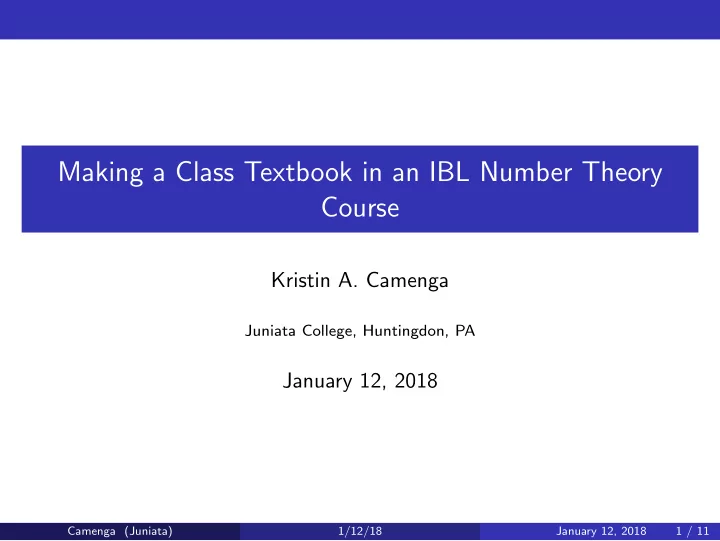

Making a Class Textbook in an IBL Number Theory Course Kristin A. Camenga Juniata College, Huntingdon, PA January 12, 2018 Camenga (Juniata) 1/12/18 January 12, 2018 1 / 11
Context Context: Teaching Number Theory at small liberal arts colleges using Marshall, Odell and Starbird, Number Theory Through Inquiry . This is an IBL textbook and does not include proofs but only statements, which students are supposed to prove. Camenga (Juniata) 1/12/18 January 12, 2018 2 / 11
Motivation Goals: Keep the process of creating and presenting proofs central Improve student writing Maintain appropriate work levels for students and instructor Camenga (Juniata) 1/12/18 January 12, 2018 3 / 11
Overview & Benefits Idea: Have students compile a class textbook. Students take turns writing up results presented in class. Results are revised based on reviews. Final drafts are made available to the class for reference. Benefits: For each result, at least presenter and writer have creative experience with the proof. Focus on writing without overwhelming grading: instructor reads one copy of each proof and able to give detailed feedback. All students have access to final proofs written by peers. Larger access justifies comments on clarity and level of detail. Camenga (Juniata) 1/12/18 January 12, 2018 4 / 11
Take 1: Independent study Class: Two senior students in an independent study (Houghton) Coverage: Finished Chapter 1-4, 6, and Ch 7 up to quadratic reciprocity Students used a shared LaTeX document (ShareLaTeX). Students included key definitions, statements of results, etc. so it read like a textbook. Each week, several problems were assigned to each student to write up. They wrote drafts and met midweek to discuss and revise. I looked at revised copy and gave verbal comments. Camenga (Juniata) 1/12/18 January 12, 2018 5 / 11
Take 2: Sophomore level class Class: 9 students in a half-semester course immediately following a half-semester transition course, taught by the same instructor Coverage: Finished most of Ch 1 and 2, selections from Ch 3 and 4 to reach Euler’s Theorem Continued emphasis on writing from transition course, but turned the focus to creating proofs One student presented, another student wrote the proof and a third student served as reviewer. (No LaTeX required) Process: = = = Presentation Draft Review Final Copy ⇒ ⇒ ⇒ class 1 before class 2 within 36 by 4pm day hrs of draft of class 3 Final copy posted on Moodle for all to access 6-7 written proofs per student and 3 reviews Camenga (Juniata) 1/12/18 January 12, 2018 6 / 11
Take 3: Junior and Senior level class Class: 6 juniors and seniors who had completed a full semester transition course; half had taken a semester of abstract algebra (Juniata) Coverage: Ch 1-4, selections from 6 and 7 to discuss and use Quadratic Reciprocity, but with more teacher presentation Students took turns writing up proofs that had been presented; LaTeX drafts due before next class after presentation. No reviewers assigned; instructor gave feedback. Student revised; final proof to be turned in before 2nd class after presentation. Adjusted midsemester to at most one written proof per week. 8 written proofs each, plus 2-3 proofs that everyone wrote up and brought to class. Camenga (Juniata) 1/12/18 January 12, 2018 7 / 11
Variation I found it helpful to sometimes vary the process for reasons of efficiency and discussion: Groups of students complete proofs. No reviewer was needed. (similar proofs) Every student writes a proof and groups compare in class. After a presentation and development of key ideas, compare several written proofs of the result from others. (difficult proofs) Camenga (Juniata) 1/12/18 January 12, 2018 8 / 11
Grading In the class settings, each proof was graded according to the following rubric. In between grades were given as well (e.g. Check/Plus) Grade Write-up Plus Typed draft required only revision for clarity of communication fixed in revision and final draft was excellent Check Main ideas of proof were complete and accurate when submitted for review and revised appropriately for sharing to achieve a nicely formatted result Minus Missed a main idea or significant issues in written format or notation requiring 2nd revision A = Mostly plusses, no minuses B = No minuses and 1-2 plusses C = Up to 1/3 minuses Together with presentations, this accounted for 30-35% of the grade. Camenga (Juniata) 1/12/18 January 12, 2018 9 / 11
Reflections This met the desired goals. Students focused on proof creation, but worked on writing Instructor workload was reasonable, with an average of 7-8 new proofs per week to read. Effect: Good opportunities to work with students individually on writing, especially with instructor as reviewer. Timing: More struggle to get students to turn in proofs on time with juniors and seniors. Reference: Students commented that they could access the proofs on Moodle for review. They did this less as the semester continued. Camenga (Juniata) 1/12/18 January 12, 2018 10 / 11
Suggestions & Ideas Make sure the method keeps workload appropriate for the size of the class: probably about 1 proof to write up a week is appropriate. Adjust for your institutional climate. Be specific if you have a desired format: e.g. Is it required to include the statement of the result? Should “Proof” be marked at the start with a � at the end? There may be collaborative LaTeX options now for larger classes. Camenga (Juniata) 1/12/18 January 12, 2018 11 / 11
Questions, Comments & Suggestions Thank you for coming! Please contact me at camenga@juniata.edu with any comments or questions! Camenga (Juniata) 1/12/18 January 12, 2018 12 / 11
Recommend
More recommend